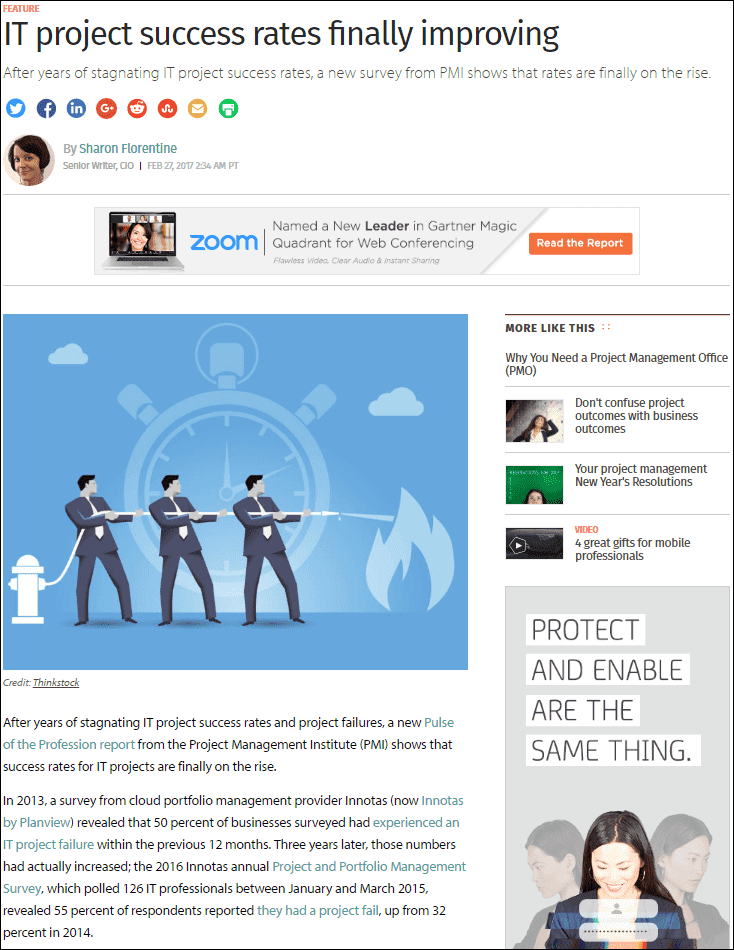
After years of stagnate IT project success rates, it looks like the tide is turning, according to the 2017 Pulse of the Profession report from the Project Management Institute (PMI) – a promising message for PMO leaders and C-level stakeholders alike.
The ninth global project management survey features insights from 3,234 project management professionals, 200 senior executives, and 510 PMO directors, from a range of industries.
Here’s some of the findings I think you will find compelling:
Responses showed that organizations wasted $97 million on average for every $1 billion invested due to poor project performance. OK, that may not seem like a huge leap forward over last year – $122 million wasted per $1 billion invested – but consider that the organizations surveyed wasted 20 percent less year-over-year. It is a significant savings. So what accounts for this higher success rates for IT projects?
By using success metrics as a gauge, the PMI separated organizations into two distinct categories: Champions and Underperformers.
- Champions complete 80 percent or more of projects on-time, on-budget, and on-target with higher benefit maturity
- Underperformers see 60 percent or fewer projects completed on-time, on-budget, and meeting original goals and business intent, with lower benefit maturity
- Only 6 percent of Champions experienced projects deemed failures
- 24 percent of Underperformers experienced projects deemed failures
A recent CIO.com article exploring these survey results points out that many organizations are focusing less on the means and more on the ends. By maturing their project management abilities, businesses can focus on benefits and outcomes, instead of solely on cost, time, and resources.
Planview’s chief product officer Patrick Tickle is quoted in the article:
“Digital convergence is collapsing the gap between business and IT. For so many years, we talked about how to better align IT with strategic business goals, and now it’s just a fact of life. That forces IT — and companies’ PMO [project management office] — to emphasize planning and prioritization, which helps them succeed with the projects that are truly important.”
Patrick has a compelling blog series that discusses this and more in greater depth that I think you will find interesting, Eight Reasons Why Your Business Strategy Might Just Fail.
When it comes to increasing project success rates here are other common factors and report highlights:
- The number of organizations with actively engaged executive sponsorship is increasing – averaging 62 percent compared to 59 percent in 2016
- Half of those surveyed with a project management office (PMO) also have an enterprise project management office (EPMO)
- Of those who align their EPMO to strategy execution, 38 percent report that more projects meet original goals and business intent and 33 percent fewer projects are deemed failures
The PMO plays a critical role in making sure the right projects are prioritized and delivered, therefore the PMO must have a seat at the decision-making table. I like these statistics because they speak to Carina Hatfield’s message urging organizations and their executives to rethink the role of PMO. The PMO itself needs to change the conversations they have with their stakeholders. I highly recommend watching her video series Be That PMO. It provides prescriptive recommendations to make the shift to not only improve project delivery but ensure the organization is focused on projects with the greatest value while improving project success rates.
And finally, I want to mention this interesting point brought out in the CIO article.
- A full 71 percent of organizations are using agile approaches for their projects sometimes or more frequently – and are more likely to report successful projects
When it comes to Agile, Patrick mentions that it’s becoming less about following strictly defined agile processes and more about creating agility. He urges organizations to figure out what is going to best enable the business and get the project done versus what it looks like from a methodology perspective.
I agree. It’s not just about methodology. The way we work is much different and it continues to shift. It’s about having the right tools to get work done.
It’s never too late to close performance gaps in your project success rate. Take a look at the links offered in this blog to get a more in-depth analysis on the subject matter. Read the CIO article and PMI surveys and see how your organizations stacks up.
What do you think about the findings and information provided?
Please share your thoughts below.



![Fuel Decisions with Data by Making the PMO a Strategic Partner [Webinar]](https://blog.planview.com/wp-content/uploads/2018/09/Fuel-Decisions-with-Data-by-Making-the-PMO-a-Strategic-Partner.jpg)

